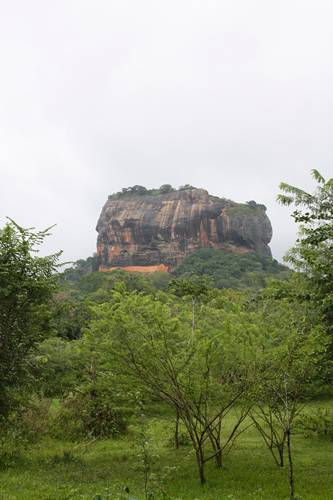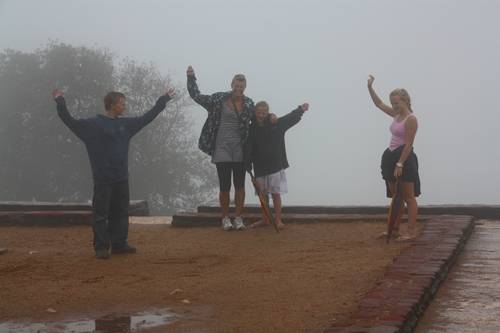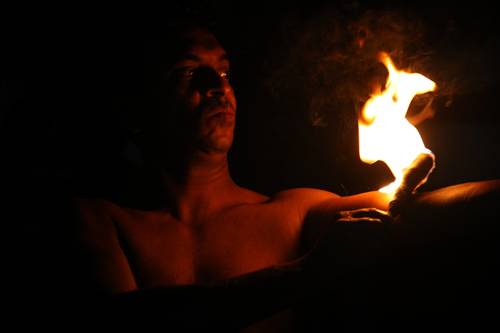Sigiriya and Kandy

Jackamy
Paul & Derry Harper
Fri 14 Jan 2011 14:24
|
Friday 14th January
A few lessons were learnt in that first day
and consequently Andrew left in the morning, leaving us with our other guide
Michel and the driver Hemantha. There was no need for 2 guides in the first
place and it wasn't right that one of the guides would have to sit in the back
of the coach with us. From now on we would have full control of where and when
we went and if we made our own mistakes, so be it. But we weren't going to be
bullied into booking somewhere just because they got free or cheap accommodation
and meals which is what had happened.
First stop this morning, Sigiriya Rock. Sigiriya Rock
is many things to many people. For history buffs it has associations with both
king and clergy. Art aficionados will appreciate the brilliant frescoes painted
high up on its sheer walls and for us casual tourists, it was simply an awesome
sight with supposedly amazing views. But we will have to take other peoples word
for that as when we climbed up to the top it was raining, we were in the mist
and consequently had zero visibility.
 Sigiriya is the hardened magma plug of an extinct
volcano that long ago eroded away. With natural cave shelters and rock
overhangs, the rock may have been inhabited in prehistoric times. Popular myth
says that the formation served royal and military functions during the reign of
King Kassapa (AD 477 -495), who allegedly built a garden and palace on the
summit. A new theory, supported by archaeological evidence instead of local
legend, suggests that Sigiriya was never a fortress or palace, but rather a long
standing Theravada and Mahayana Buddhist monastery built several centuries
before the time of King Kassapa. After the 14th century the complex was
abandoned. British archaeologist HCP Bell discovered the ruins in 1898, which
were further excavated by British explorer John Still in 1907.
You enter the sight through the royal gardens and then
begin to climb through the boulder gardens. Half way up the rock, there's a
spiral stairway leading up from the main route to a long, sheltered gallery in
the sheer rock face. In this niche is a series of paintings of women. Modern
theory suggests the female forms represent aspects of Tara - a bodhisattva and
one of the most important figures in Tantric Buddhism. They were nice to see but
I'm not sure they were worth climbing up the rusty, rickety old spiral staircase
suspended from the side of the rock.
  Walking through the gardens
  Up the water logged steps and the rusty
spiral staircase
  Rock paintings
We had been warned about people latching on to you to
be your guide and then trying to charge you at the end. But we failed to notice
when we were being conned whilst looking at the paintings. A local
man offered to lean Sheila's umbrella up the wall whilst she took
pictures. She accepted and told him to leave it where it was. Anyway, a few
minutes later when we left the umbrella had gone but Sheila just presumed
someone had taken it. When we re-grouped at the bottom and realised it was
missing, the local man came running down the stairs with the umbrella and
demanded 300 rupees. It was all a trick!
Next we climbed up the main bulk of the rock to
the remains on the top. In years to come it wouldn't surprise me if the steps
were to give way, it really is an accident waiting to happen, but
thankfully we made it up and down safe and sound. The fact that we couldn't see
a single thing probably helped as we couldn't actually tell how high up we were.
The top of the rock covers 1.6 hectares. At one time it
was covered with buildings, but only the foundations remain today. The design of
this so called palace, and the magnificent views suggest that Sigiriya was more
a place of residence than a fortress. A 27 metre by 21 metre pond looks like a
modern swimming pool, although it may have been used merely for water storage.
   Rain rain go
away.............
As we made our way back down the stairs we
emerged onto a large platform, from which the rock derives its later name - the
Lion Rock. HCP Bell, the British archaeologist responsible for an enormous
amount of archaeology in Sri Lanka, found the two enormous lion paws when
excavating in 1898. At one time a gigantic brick lion sat at this end of the
rock, and the final ascent of the stairway to the top commenced with a
stairway that led between the lion's paws and into its mouth. The 5th century
lion has since disappeared, apart from the first steps and the
paws.
  It's daunting going back down
 As we began to make our way south to Kandy,
the main hill city, we stopped off at Dambulla, famous for it's Royal Rock
Temple. The temple sits 100 to 150 metres above the road and is filled with
about 150 Buddha images. We didn't have time to climb up the temple though so we
just had a wonder around the Golden Temple situated at the foot of the hill. The
Golden Temple is a very kitschy structure with a 30 metre high sitting Buddha
image in the dham-machakka mudra (wheel-turning pose). Signs claim that it is
the largest Buddha in the world, but it's not even the largest in Sri Lanka.
   Monks walking to the temple
We arrived in Kandy just in time for the
Kandyan dance at the cultural centre. The dance flourished under the Kandayan
kings and when Buddhist monks admitted it to temple courtyards it became an
essential part of the Kandy Esala Perahera and it is now considered Sri Lanka's
national dance. Male Kandayan dancers wear a wide skirt like garment. The
dancer's bare chest is covered with necklaces of silver and ivory, with bangles
of beaten silver on the arms and ankles. The dances combine great leaps and
energetic back flips accompanied by the complex rhythms of the geta bera, a
double ended drum combining monkey and cow hides.
After the dance a couple of men treated us
to a fire walking show. I've never seen one before and it was definitely
worth sitting through the boring Kandyan dance. The heat coming from the hot
rocks was intense. They even rubbed the flaming sticks on their skin and on
their tongues. Crazy crazy men! How do they learn that they can do
this!
    |